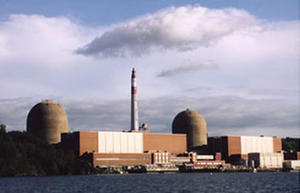Nuclear powerNew York governor determined to close Indian Point nuclear plant
The Indian Point nuclear power plant, located thirty-five miles north of New York City, is facing increasing pressure from Governor Andrew Cuomo and senior officials say the governor is determined to shut it down; the governor’s hand has been strengthened by new legislation that streamlines the approval process for siting new power plants in New York, a move that would make it easier to replace Indian Point; closing the nuclear plant would be a major step toward reshaping the state’s energy policy as the plant produces 2,000 megawatts and provides New York City and Westchester with 25 percent of their power — but the nuclear disaster in Japan caused by the 11 March earthquake and tsunami raised fresh concerns about the plant, which is located near a fault line

Indian Point is on Gov. Cuomo's hit list // Source: rcaro.org
The Indian Point nuclear power plant, located thirty-five miles north of New York City, is facing increasing pressure from Governor Andrew Cuomo and senior officials say the governor is determined to shut it down.
Governor Cuomo has often made it a point in speeches to declare his opposition to the nuclear plant, but two weeks ago, officials at Entergy, the operators of the Indian Point plant requested a meeting. The meeting was the first high level meeting between the company and the Cuomo administration, and senior company officials left alarmed by Cuomo’s strong intentions.
The governor’s hand has been strengthened by new legislation that streamlines the approval process for sitting new power plants in New York, a move that would make it easier to replace Indian Point.
Closing the nuclear plant would be a major step toward reshaping the state’s energy policy as the plant produces 2,000 megawatts and provides New York City and Westchester with 25 percent of their power.
The nuclear disaster in Japan caused by the 11 March earthquake and tsunami raised fresh concerns about the plant, which is located near a fault line. In particular officials worry that a similar disaster would have catastrophic consequences for New York City’s eight million residents who could be forced to evacuate.
In defense of the plant, James F. Steets, a spokesman for Entergy, said, “Indian Point provides 25 percent of NYC’s and Westchester’s power for subways, schools, police stations and firehouses, businesses and homes with virtually no emissions, at lower cost.”
He added, “Entergy’s investment in recent years of more than a half-billion dollars to upgrade safety and security, and rigorous independent inspections by multiple inspectors on site full time, help ensure Indian Point is safe.”
David Lochbaum, the director of the nuclear safety project at the Union of Concerned Scientists, explained that the difficulty in replacing Indian Point was related more to the transmission of existing power than generating power. Local governments have refused to allow new transmission lines to be built that would bring power from the north to New York City and its suburbs.
“If you took Indian Point out of the mix, one of the options would be to replace it with more power from upstate New York or Canada, but the power lines are already at capacity,” he said. “The power might be there, but not the ability to get it to people who need it.”
The governor is currently pushing a plan to connect New York City and New Jersey with transmission lines buried beneath the Hudson River to deliver 660 megawatts of energy to Manhattan, but the proposal faces fierce opposition as well.
License for Indian Point’s two reactors are set to expire in 2013 and 2015, but the state could disrupt the plant’s operations even sooner by refusing to provide permits for the use of water from the Hudson River as a coolant. Entergy is currently battling with the State Department of Environmental Conservation over its decision to reject the company’s application for a critical permit.
